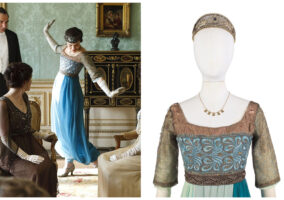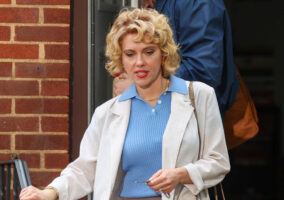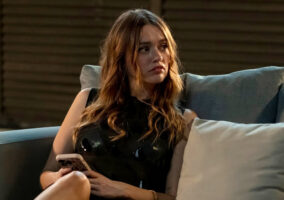![]() Pin
Pin
We’d love to cultivate a reputation of expert-level cinematic costume design knowledge, but we have to admit that we’re learning things as we work our way through this series. Now that we’ve got a decent amount of these posts under our belt, we’ve formulated a couple of ideas and concepts that hadn’t occurred to us before.
![]() Pin
Pin
One of the more persistent ones is the idea of the “debut costume.” By that we mean a costume that doesn’t just introduce you to the character, it introduces you to the actress playing her, who is in many instances debuting in her first major starring role. There’s something about Vivien Leigh’s introductory costume in Gone with the Wind or Judy Garland’s in The Wizard of Oz or Tippi Hedren’s in The Birds that feels like the film stepping back for a second and saying “Here she is, folks. Get a good look” before launching into her story.
![]() Pin
Pin
But we don’t think there’s a costume in film history more overtly introductory, more obviously about getting your first good look at the star wearing it, than Barbra Streisand’s leopard wrap coat and cloche hat in 1968’s Funny Girl. She literally introduces herself while wearing it, in one of the most famous debut sentences in film history: “Hello, gorgeous.” We maintain that anyone with a modicum of film knowledge is unable to look at a picture of Barbra in this costume and not hear that line. And if you’re a gay man over 40, there’s a 75% chance you will be unable to prevent yourself from saying it out loud.
![]() Pin
Pin
The point to this opening scene and costume is ostensibly to establish Fanny as a fully glamorous superstar before flashing back to her humbler beginnings. It does this in the direction by taking its time introducing her and forcing you to wait for her to turn to the camera and show us the face that had been in all the magazines since it first debuted in the role on Broadway.
![]() Pin
Pin
But it also does all this with the costume, which is rich, luxurious, and glamorous. It speaks of money and the kind of hyper-trendiness you would expect from any pop music superstar. This is Fanny Brice at the height of everything – fame, money, looks and talent.
![]() Pin
Pin
The entire story that’s about to unfold for the next two hours is in this costume, including a subtle call to the memorable orange skirt and jacket she wears for the “Don’t Rain on My Parade” number when she runs to declare her love to Nicky (even though everyone in her life told her not to) as well as a not-so-subtle focus on the massive diamond ring he gave her. The story’s all foreshadowed in the costume design here: glamour, fame, wealth, defiance, love, marriage – matched with an unhappiness in the performance that has the audience wanting to know more.
![]() Pin
Pin
![]() Pin
Pin
The first thing that’s interesting to note is that the costume is pretty accurate for the period (which wasn’t always assured in films of the ’50s through the ’70s). The clamshell-style fur coat and cloche are on point for the mid 1920s, but her hair and makeup are coming at ya straight from 1968. The short bouffant, winged eye, pale lip and long nails were all way off base for this time period. This is Barbra Streisand’s film debut and from the very first seconds of screentime, her entire star persona for the next half-century is locked into place. This tension between costume and styling is not a coincidence. In fact, it’s visual evidence of a subtle tension that plays out through the rest of the film; a tension between the script, Streisand’s performance, Streisand’s look, and the expectations of the musical biopic genre of film.
![]() Pin
Pin
Fanny’s story is in most ways a fairly standard rags-to-riches, rise-to-stardom sort of musical biopic, but the emotional foundation of the story, the thing that defines Fanny’s arc without ever being fully articulated in the dialogue, is an even more standard “ugly duckling turns into swan” tale. What makes it so interesting and adds a subtle bit of tension to the film is that Barbra clearly isn’t playing the character that way even though the script and lyrics ask her to.
Let’s pull out of this opening scene for a second and talk about Fanny’s stage debut as a chorus girl at Keeny’s. After completely ruining the number with her horrible roller-skating skills to the delight of the audience, she gets the stage to herself and does this:
Fanny starts the number off shyly, her voice barely above a whisper. By the end, she’s belting it Barbra-style in full command of the stage. Now, there are two ways to look at why she managed the entire number without one fumble or fall despite her flailing around moments before. Either Fanny just needed a little attention and encouragement to gain the control to suddenly become much more skilled at roller-skating and deliver a flawless number – which is, to be fair, a fairly standard rise-to-stardom biopic trope – or Fanny’s comic pratfalls and fumbles were shtick, shrewdly applied to keep all attention on her. We tend to think it’s the latter because we think that’s how Barbra’s playing it, biopic conventions be damned.
![]() Pin
Pin
Fanny is many things, but insecure and shy do not come to mind when you consider Streisand’s portrayal of her. Her entire career as an actress has been characterized by a reputation for being “difficult” when in reality, she was simply supremely confident about who she is, how she wants to present herself, and what the audience will expect from her. Given the results, who can honestly say she was ever wrong about such things?
![]() Pin
Pin
Our point: Even though the script has her so enamored of Nicky Arnstein because she thinks his beauty renders him out of her league or has her singing a lyric that references her nose in the first ten minutes (which she plays defiantly rather than woefully, we might add), Barbra never really plays Fanny as insecure about her looks. Even the “His Love Makes Me Beautiful” number, which Fanny refuses to do straight, is less about her not feeling beautiful and more about her knowing what she’s best at delivering. She’ll pretend she can’t roller-skate, pretend she’s shy to have the spotlight on her, and pretend she doesn’t think she’s beautiful in order to gain the audience’s attention and hold on to it. Fanny’s not insecure. She acts like she is because it makes for great shtick.
![]() Pin
Pin
Other examples: when she meets Nicky Arnstein for dinner the first time and she drops her cloak to the floor in shock at the grandeur of the room, she smiles to herself demurely when Nicky picks it up for her. Everything is a “bit” to Fanny; every part of her life is a performance on some level. The lyrics to “I’m the Greatest Star” could be played as someone pleading to be recognized, but Barbra sings nearly the entire song with a heavy level of sarcasm that morphs into defiance by the end of it. She’s not trying to convince herself; she’s annoyed it’s taking everyone else so long to realize it. Barbra simply refused to play this character as anything less than brimming with self-confidence, so when the story, script or lyrics asked her to play it otherwise, she always added some little moment or inflection to make sure you understand how little she believes it. This isn’t to say she’s not really overwhelmed by the beautiful Nicky, but that’s honestly more about her wanting to lose her virginity to him than feeling like she didn’t deserve him.
![]() Pin
Pin
What does all of this have to do with this costume and this scene? Merely this: “Hello, gorgeous” could be seen as Fanny being a bit self-deprecating and we suspect that was the expectation for it as written. But this is not a woman who doesn’t like what she sees in the mirror. Quite the opposite.
![]() Pin
Pin
Barbra plays this entire scene with her glamour lamps turned on full-blast. The nails, the eyes, the profile, the swooning and subtle self-confidence – what made her such a big star so quickly is that she absolutely knew from the start who she was and what her angles were. She fought with the film’s director William Wyler and the film’s costume designer Irene Sharaff (both of them absolute legends in the industry with a herd of Oscar statues between them) about how she wanted to play the character (which, to be fair, she created on the stage) and how she wanted to look onscreen and we think you can see the inarguable results in this opening scene and look.
![]() Pin
Pin
We don’t necessarily think she was playing against director Wyler’s wishes (or Sharaff’s, necessarily); not their final wishes, anyway. After she won whatever arguments she won, the director, like Hitchcock with the eerily low-emotive Tippi Hedren in The Birds, was deliberate about that tension between script, performance and directing style. He made sure to shoot Barbra in the most dramatically glamorous possible way in practically every scene – including the ones where she’s supposed to be insecure or self-deprecating. And Sharaff similarly refused to let her look anything less than gorgeous even in her pre-stardom scenes. Note that when the film flashes back to her early years; when she’s supposed to be little more than a girl (in a cute, colorful, and expensive-looking sailor outfit, no less), she still has the winged eye, lacquered hair and long nails she sports in this – and every other – scene.
![]() Pin
Pin
Ultimately, we think the film is legendary, Barbra is a superstar, and this costume is iconic all for largely the same reasons: because the icon wearing it knew she was an icon-to-be and played the character her way, in her style, with her look and her innate understanding of the character. Not insecure or shy – not even a drop of it. A diva from the second she stepped onscreen and a legend from the moment she opened her mouth to introduce herself.
[Stills: Columbia Pictures via Tom and Lorenzo]
Jennifer Lopez on “World of Dance” in Balmain: IN or OUT? Next Post:
Pop Style Opinionfest: Eek, Veep, WAP!
-
 Pin
Pin
Bonhams to Open the Doors to DOWNTON ABBEY with Major Auction of Costumes and Props
-
 Pin
Pin
Scarlett Johansson Filming PAPER TIGER in New York City
-
 Pin
Pin
The Wardrobe Department: Aimee Lou Wood’s Chelsea Wears Alexander McQueen on THE WHITE LOTUS
Please review our Community Guidelines before posting a comment. Thank you!
